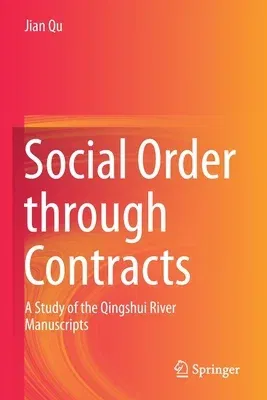Abstract Dates and Currency I. Introduction 1. The story of the
wealthiest 2. Research question: A contract society? 2.1. Economic
success, social order, and contracts 2.2. The general puzzle of how and
why the contract worked 3. Sources: The Qingshui River region and beyond
3.1. A brief introduction to the Qingshui River manuscripts and their
studies 3.1.1. The discovery 3.1.2. Where and when?3.1.3. The content
3.1.4. Major collections, publications, and state of the field 3.2.
Sources in and beyond the Region 3.2.1. Taking the Qingshui River
manuscripts as the core source 3.2.2. Wendou, a cluster of villages, the
region, and beyond 4. Synopsis and structure of this study II.
Rediscovering Contract in the Qingshui River Region 1. Introduction:
Standard and borderline contracts 1.1. A general and complex term 1.2.
"Standard cases" and "borderline cases" 2. Contracts in law and practice
2.1. Contracts in contract laws 2.1.1. Defining contract in laws: A
comparative approach 2.1.2. Contracts and the Great Qing Code 2.1.3.
Contracts without contract law? 2.2. Categorization of contracts in
everyday life 2.2.1. Contractual manuals 2.2.2. A necessary hypothesis
3. Contents of a contract: Beyond agreement i Table of Contents 3.1. The
tense of a contract: Future or past? 3.2. The performance of contracts
3.2.1. Contracts need no performance 3.2.2. Producing contracts as the
performance 3.3. Championing the past in the future 3.3.1. Negative
obligations in the future tense 3.3.2. The established and confirmed
3.4. Transcending as an agreement 3.4.1. Contract without agreement?
3.4.2. Jural relations: An external observation 4. Identifying contracts
by form: The internal and external 4.1. The textual form 4.1.1.
Essential elements? The changing and unchanged 4.1.2. Specialized
language and formulaic expressions 4.2. The ritual form 4.2.1. Customs
of contracting 4.2.2. Textual reflections 4.3. The formulaic beginning
of a contract: Indicating and integrating 4.3.1. The formula of the
beginning 4.3.2. Integrating the form and content 4.3.3. The indicator
as a shortcut 5. Paper matters: The materiality of contracts 5.1. The
burning of contracts 5.1.1. The story of Yao the Millionaire 5.1.2. A
contract of dispute settlement 5.2. The non-conceptual contract: The
contract and its material carriers 5.2.1. The abstract and concrete
contract 5.2.2. Material carriers other than paper 5.3. The validity of
the material: Oral and non-original 5.3.1. Oral contracts5.3.2. Copies
of the contract 6. Conclusion III. Middlemen1. Introduction:
Understanding middlemen within a contract 2. The primary and the
secondary: Formation and restoration 2.1. Four roles 2.2. Two levels 3.
The primary: Introducers, witnesses, and guarantors 3.1. Introduction
3.1.1. Matchmaking and facilitation 3.1.2. Duzhong ii Table of
Contents3.1.3. Hanzhong 3.2. Witnessing 3.3. Guarantee 4. The secondary:
Arbitrators and peacemakers 4.1. The "original middleman" 4.2.
Arbitration 4.2.1. Fact-finding 4.2.2. Reasoning 4.3. Mediation 5. The
middleman as the th


